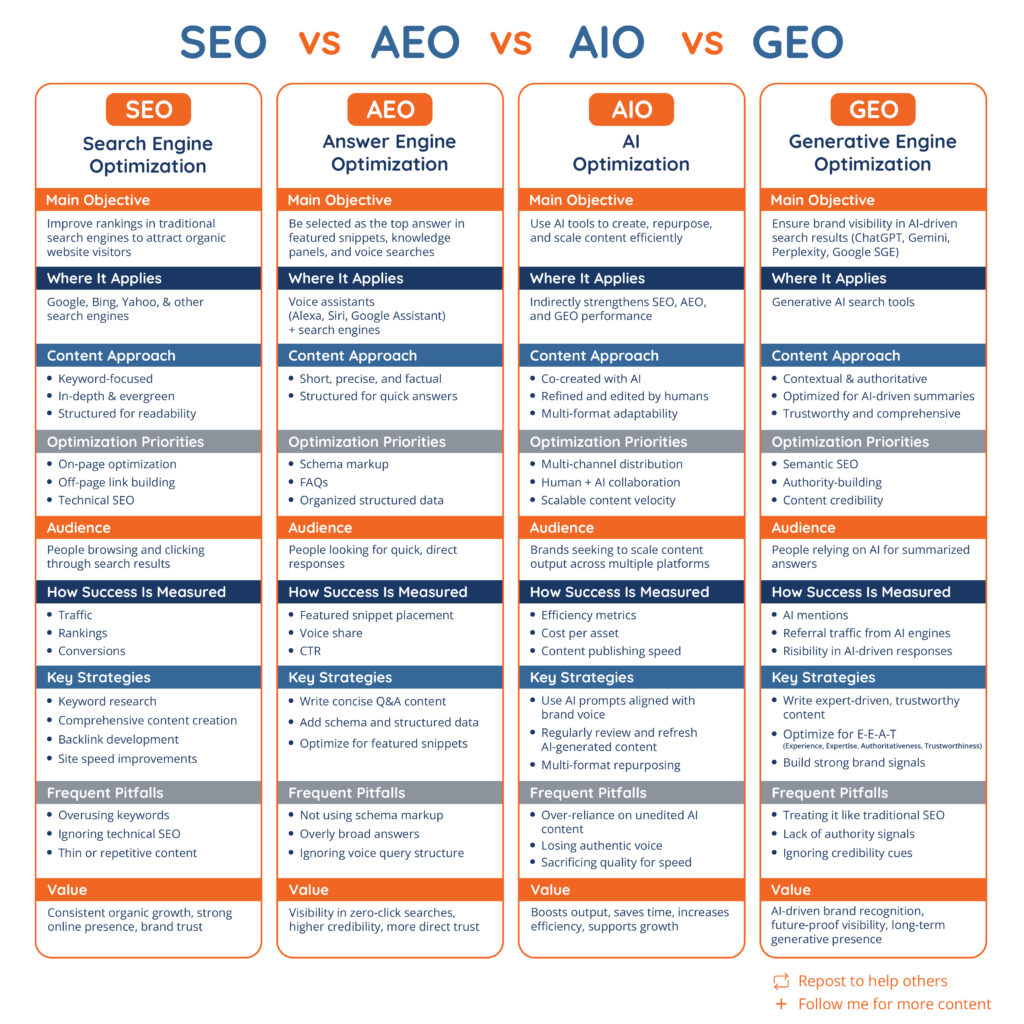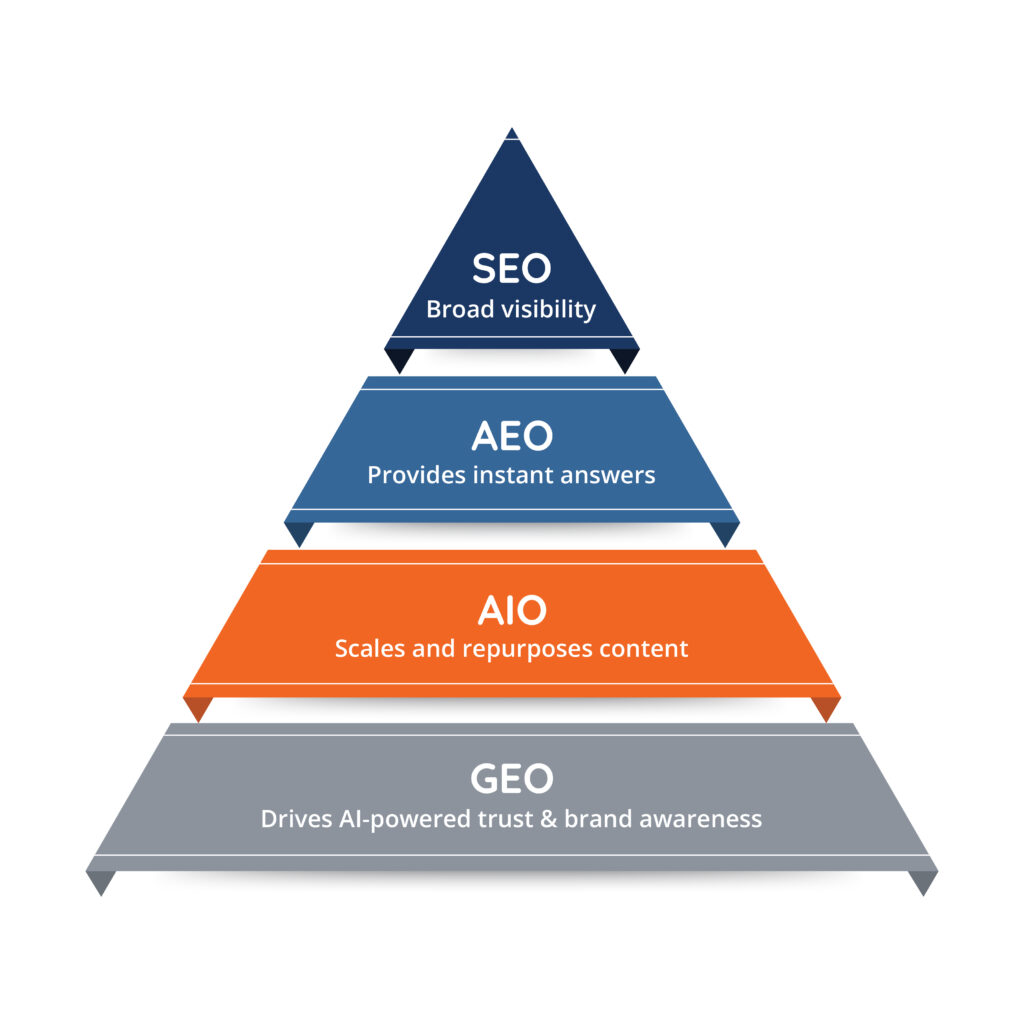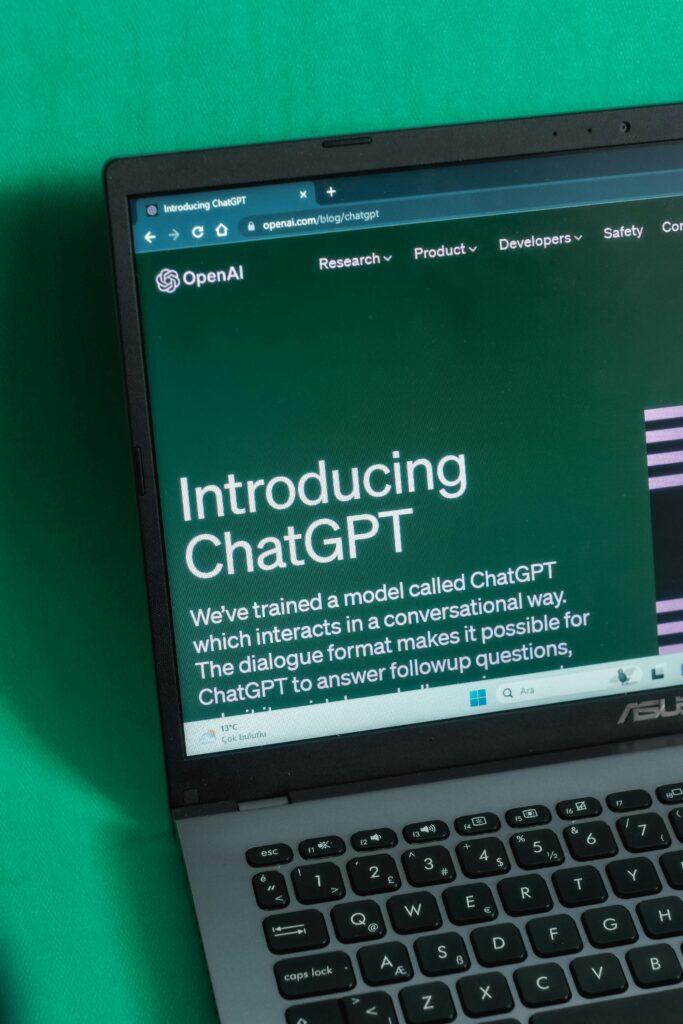The search landscape is fracturing. While Google still dominates with 86% market share, AI-powered platforms are rapidly reshaping how users find information. Gartner predicts traditional search volume will drop 25% by 2026 as users shift to AI chatbots and answer engines.
This evolution from SEO to Answer Engine Optimization (AEO) and now Generative Engine Optimization (GEO) isn’t just technical jargon. It’s a fundamental shift in how brands maintain online visibility.
Understanding these distinctions and overlaps will determine which businesses thrive as search transforms from ten blue links to conversational AI experiences.
Defining AEO (Answer Engine Optimization)
Answer Engine Optimization focuses on becoming the direct answer that search engines deliver to users without requiring a click. It’s about winning position zero that coveted spot above all organic results.
Goal: Optimize Content for Direct Answers
AEO aims to capture featured snippets, voice search responses, and zero-click answers. Voice assistants pull 40% of their answers from featured snippets, making AEO essential for brands targeting voice search users. Success means your content appears as the definitive answer, even if users never visit your site.
Tactics: Featured Snippets, FAQs, Structured Data, Clear Formatting
Winning featured snippets requires precision: craft 40-60 word answers positioned immediately after relevant headers. Implement FAQ schema markup to explicitly signal question-answer pairs.
Use conversational headers that mirror how people actually ask questions – “What is email marketing automation?” beats “Email Marketing Automation Definition.”
Examples: Google Featured Snippets, Voice Search
Google’s featured snippets capture 35% of clicks when present. Voice platforms like Alexa and Siri rely on structured content to provide spoken answers.
Each platform has unique selection criteria – what works for Google Assistant might not work for Siri, requiring platform-specific optimization.
Defining GEO (Generative Engine Optimization)
GEO focuses on being cited when AI synthesizes information from multiple sources.
Goal: Optimize Content for Generative AI Outputs
GEO ensures your brand appears in AI-generated narratives across ChatGPT, Perplexity, Claude, and Google’s AI Overviews.
The goal isn’t just citation but favorable representation – you want AI accurately describing your products and positioning your brand as authoritative.
Tactics: Long-form Authority Content, Trustworthy Sources, Contextual Relevance
Generative engines favor depth over brevity. Adding statistics improves visibility by 22%, while expert quotations boost impression scores by 37%. Create comprehensive content with original research, detailed methodologies, and clear sourcing. Make individual paragraphs self-contained since AI often extracts specific passages rather than entire articles.
Examples: Perplexity Citations, ChatGPT Knowledge Integration
Perplexity displays numbered citations linking to sources, driving both visibility and traffic. ChatGPT’s browsing mode prioritizes recent, authoritative content. Google’s AI Overviews synthesize multiple sources, often citing sites that combine strong SEO with comprehensive coverage.
Key Differences Between GEO & AEO
Understanding these distinctions helps allocate resources effectively between two fundamentally different optimization approaches.
Engines: AEO = Search-based Answer Engines; GEO = Generative AI Engines
AEO targets systems that extract existing content – Google Featured Snippets, Bing instant answers, voice assistants. These engines identify and present the most relevant passage from indexed pages. GEO targets systems that create new responses by synthesizing multiple sources – ChatGPT, Claude, Perplexity. They interpret, combine, and reformulate information into original compositions.
User Experience: AEO = Single Short Answers; GEO = Narrative, Multi-source Answers
AEO delivers one definitive answer to specific questions – perfect for quick facts or simple instructions. GEO enables conversational interactions with comprehensive responses drawing from multiple perspectives, allowing follow-up questions and exploration.
Optimization: AEO = Concise, Schema-driven; GEO = Depth, Authority, and Training-data Visibility
- AEO tactics: FAQ schema markup, 40-60 word answers, conversational long-tail keywords, structured data implementation
- GEO tactics: Comprehensive pillar content, original research with methodology, expert quotations and citations, topical authority building
- AEO metrics: Featured snippet ownership (binary – you win or lose), voice search rankings, zero-click answer rates
- GEO metrics: AI citation frequency (probabilistic – varies by query), brand mention sentiment in AI responses, visibility across different models
Citations: AEO Sometimes Credit-free; GEO More Reliant on Visible Attribution
Featured snippets often display your content without clear attribution. Voice assistants rarely mention sources. Conversely, generative engines increasingly emphasize citations – Perplexity shows numbered references, ChatGPT displays sources, and Google’s AI Overviews include reference links. This visible attribution builds authority through repeated citations.

Where AEO & GEO Overlap
Despite differences, both optimizations share core principles that smart marketers can leverage for unified strategies.
Both prioritize clarity, accuracy, and structured content. Clear headers, logical organization, and factual accuracy benefit both snippet extraction and AI synthesis. Well-structured content performs better whether parsed by answer engines or language models.
Both reward E-E-A-T signals. Google emphasizes Experience, Expertise, Authoritativeness, and Trustworthiness for featured snippets. AI models similarly prioritize content from recognized experts. Author credentials, first-hand experience, and original research boost performance in both systems.
Both reduce traditional “10 blue links” visibility. Featured snippets decrease clicks to standard results by 5-15%. AI Overviews cause 20-25% traffic drops. This shared disruption means brands must optimize for both to maintain visibility as traditional organic traffic declines.
How to Integrate GEO & AEO in Your Strategy
Build a layered approach that serves both optimization types without duplicating effort.
Practical Roadmap for Marketers
- Audit existing content: Identify pages ranking 2-5 for featured snippet queries (quick AEO wins)
- Create dual-purpose content: Start with concise AEO-optimized summaries, then expand into GEO-worthy depth
- Mine real questions: Use customer support tickets and “People Also Ask” for authentic FAQ content
- Invest in original research: Surveys and proprietary data serve both snippet extraction and AI citations
- Build topical clusters: Interlinked content demonstrates authority for both systems
- Track both metrics: Monitor featured snippet ownership AND AI citation frequency
Short-form Clarity (AEO)
Format answers in 40-60 words immediately after headers. Target conversational long-tail keywords like “what is the best CRM for remote teams” rather than just “best CRM.” Implement FAQ schema across all relevant pages.
Long-form Authority (GEO)
Develop comprehensive pillar content exploring topics from multiple angles. Include original data, expert opinions, and detailed methodologies. Create content hubs demonstrating complete topical coverage that AI systems recognize as authoritative resources.
Technical Signals That Serve Both
Schema markup helps both optimizations differently – FAQ schema wins snippets while Article and Organization schemas provide context for AI. Fast page speed and mobile optimization benefit featured snippet selection and AI crawler access. Consistent NAP information across platforms builds trust signals both systems evaluate.
Example Workflow: FAQ Schema for AEO + Original Research for GEO
For a topic like “email marketing benchmarks,” create an AEO-optimized FAQ answering “What is the average open rate?” in 40 words with schema markup.
Then expand with original research analyzing 10,000 campaigns, providing the depth AI systems seek. Link both elements – quick answers win snippets while detailed research earns AI citations.
The Future of AEO & GEO
The boundaries between these optimizations are already blurring as platforms converge.
Predictions: Convergence Toward “Hybrid Engines”
Google’s AI Mode combines traditional results with conversational AI, signaling the future isn’t either-or but both-and. Microsoft’s Copilot integration similarly blends search with generation. Each platform develops unique hybrids requiring adapted strategies.
The Rise of AI-Native Optimization as a Discipline
New roles emerge: AI Search Strategists, Prompt Engineers, and Synthetic Media Specialists. Tools for tracking AI citations and measuring generative visibility enter the market. This specialization requires understanding how language models train, retrieve, and generate – not just how search engines crawl and index.
Your Action Plan: Don’t Choose Between AEO and GEO – Build for Both
The evolution from SEO to AEO to GEO represents an expansion, not a replacement. Traditional SEO still drives traffic, AEO captures position-zero visibility, and GEO ensures AI accurately represents your brand. The winners won’t be those optimizing for today’s algorithms but those building lasting authority across all discovery channels.
Start with a content audit: Do you have clear, structured answers for common questions? Are you creating comprehensive, authoritative content AI can’t find elsewhere? Do you have original research and first-hand expertise to share?
Address these gaps systematically. Implement FAQ schema for quick wins while building topical authority for long-term AI visibility. Track success beyond traffic – monitor featured snippets won, AI citations earned, and brand mentions in generative responses. The future of search is already here. Make sure your optimization strategy is ready for it.





